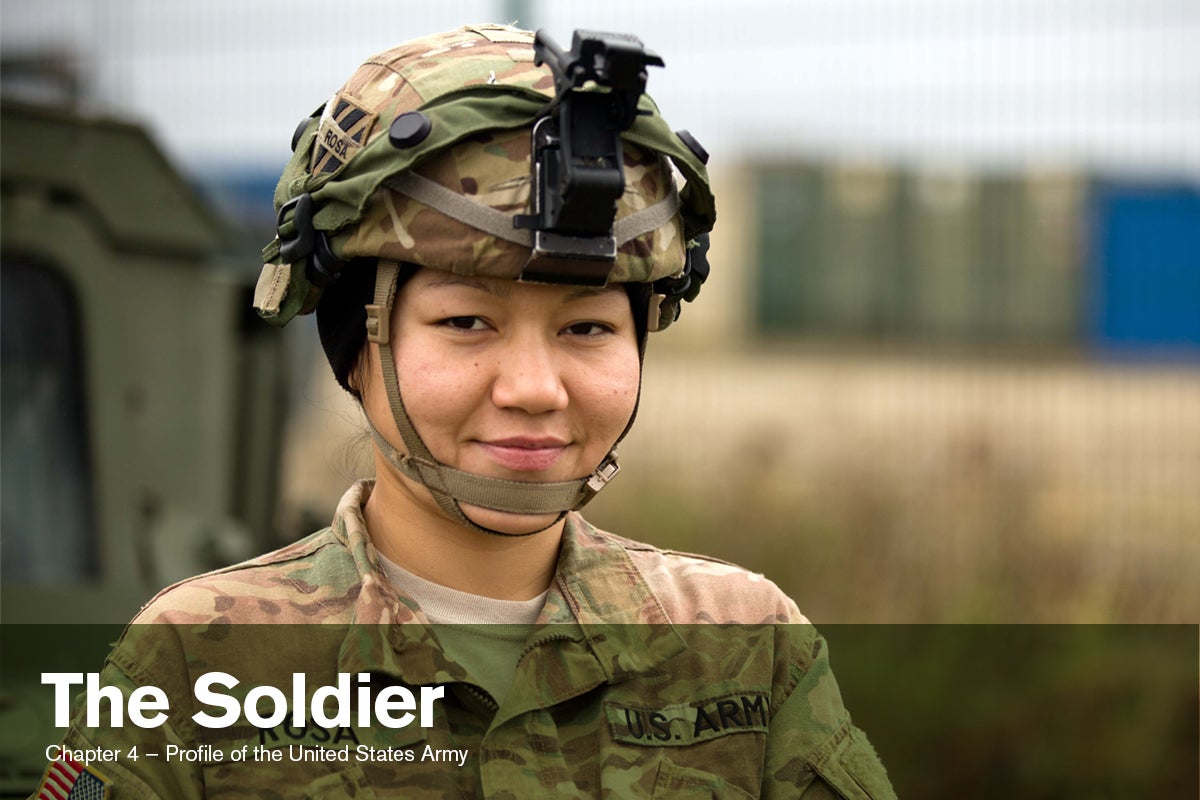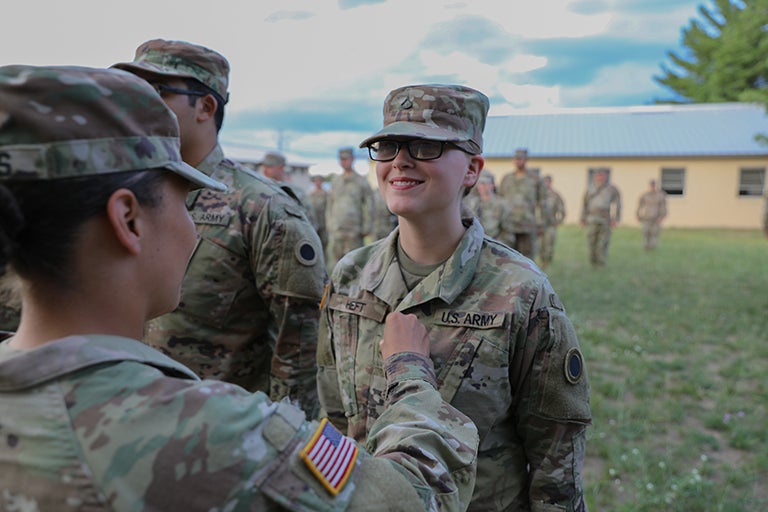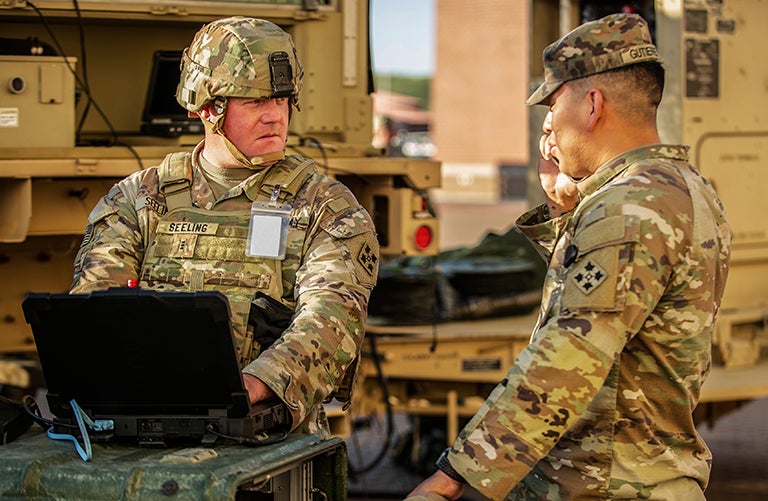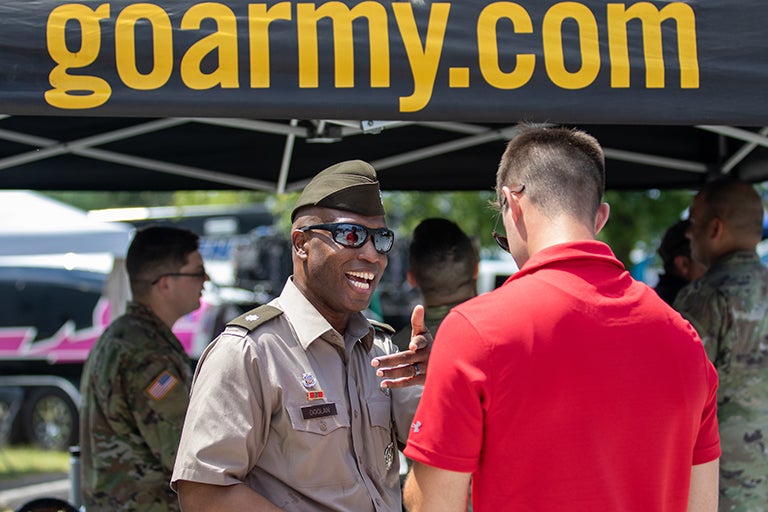Profile of the United States Army: The Soldier
Profile of the United States Army: The Soldier

This is Chapter 4 of the 2022 Profile of the United States Army, a top-to-bottom reference handbook that lays out everything you need to know about how and why the Army works—and what it’s doing around the world right now. Links to other chapters can be found at the bottom of this page.
What’s Your Warrior?
The Soldiers in the United States Army are among the best trained, most disciplined and most proficient in the world. This tradition originated in 1778, when Baron Friedrich von Steuben wrote the book on training and discipline for George Washington’s fledgling Continental Army at Valley Forge. That was the turning point in the War of Independence; von Steuben’s training gave the American Army the tools to topple the better-equipped, better-supplied and larger British army. It has been the foundation of America’s armed superiority ever since.
The individual Soldier is the basic building block of all Army organizations and operations; the strength of the Army lies not only in numbers but also in its Soldiers. Soldiers develop mental, emotional and physical strength that is forged through shared values, teamwork, experience and training, answering the question of the Army recruitment slogan: “What’s Your Warrior?”
Army Oath
Title 10 of the U.S. Code establishes the mission and organization of the Army and governs the enlistment and commissioning of the Army’s Soldiers. Upon entering the Army, Soldiers must recite a version of the oath that was established by the Continental Congress when it created the Army in 1775. The current oaths, with wording that dates to around 1960, are as follows:
Enlisted Oath
“I, __________, do solemnly swear (or affirm) that I will support and defend the Constitution of the United States against all enemies, foreign and domestic; that I will bear true faith and allegiance to the same; and that I will obey the orders of the president of the United States and the orders of the officers appointed over me, according to regulations and the Uniform Code of Military Justice. So help me God.”
Officer Oath
“I, __________, having been appointed an officer in the Army of the United States, as indicated above in the grade of __________, do solemnly swear (or affirm) that I will support and defend the Constitution of the United States against all enemies, foreign or domestic; that I will bear true faith and allegiance to the same; that I take this obligation freely, without any mental reservations or purpose of evasion; and that I will well and faithfully discharge the duties of the office upon which I am about to enter. So help me God.”
Army Values
U.S. Army Soldiers adhere to the following seven core Army values:
- Loyalty—Bear true faith and allegiance to the U.S. Constitution, the Army, the unit and fellow Soldiers. Bearing true faith and allegiance is a matter of believing in and devoting oneself to something or someone. A loyal Soldier is one who supports the leadership and stands up for fellow Soldiers. By wearing the uniform of the U.S. Army, Soldiers express their loyalty. By doing their share, they show loyalty to the unit.
- Duty—Fulfill all obligations. A Soldier doing his or her duty means more than carrying out assigned tasks. Duty means being able to accomplish tasks as part of a team. The work of the U.S. Army is a complex combination of missions, tasks and responsibilities, building one assignment onto another. Soldiers fulfill their obligations as a part of the unit every time they resist the temptation to take shortcuts that might undermine the integrity of the work of the unit.
- Respect—Treat people as they should be treated. Respect is what allows us to appreciate the best in other people. Respect is trusting that all people have done their jobs and fulfilled their duty. Self-respect is a vital ingredient too, resulting from knowing that one has put forth the best possible effort. The Army is one team, and each Soldier has something to contribute.
- Selfless Service—Put the welfare of the nation, the Army and one’s subordinates before one’s own interests. In serving their country, Soldiers are loyally doing their duty without thought of recognition or gain. The basic building block of selfless service is the commitment of all team members to go a little further, endure a little longer and look a little closer to see how they can add to the effort.
- Honor—Live up to Army values. Honor is a matter of carrying out, acting and living the values of respect, duty, loyalty, selfless service, integrity and personal courage in everything. Soldiers make honor a matter of daily living, solidifying a habit of being honorable with every value choice they make.
- Integrity—Do what is right, legally and morally. Integrity is a quality developed by adhering to moral principles. Among other things, it requires never doing or saying anything that deceives others. As a Soldier’s integrity grows, so does the trust others place in that Soldier.
- Personal Courage—Face fear, danger and adversity. Personal courage has long been associated with the Army. Physical courage is a matter of enduring physical duress and risking personal safety. Facing moral fear or adversity may be a long, slow process of continuing forward on the right path, especially if taking those actions is not popular with others. Soldiers build personal courage by standing up for and acting upon the things that they know to be honorable.
The Soldier’s Creed
In addition to the seven core Army values, all Soldiers are expected to uphold a set of principles called The Soldier’s Creed. This creed guides every aspect of their Army lives, from behavior and attitude to training and carrying out their duties and missions.
I am an American Soldier.
I am a warrior and a member of a team. I serve the people of the United States and live the Army Values.
I will always place the mission first. I will never accept defeat. I will never quit. I will never leave a fallen comrade.
I am disciplined, physically and mentally tough, trained and proficient in my warrior tasks and drills. I always maintain my arms, my equipment and myself.
I am an expert, and I am a professional.
I stand ready to deploy, engage and destroy the enemies of the United States of America in close combat.
I am a guardian of freedom and the American way of life.
I am an American Soldier.
 U.S. Army Specialist Alyssa Heft, right, a Human Resources Specialist assigned to the 37th Infantry Brigade Combat Team, Ohio National Guard, receives her new rank of Specialist during a promotion ceremony at Camp Grayling, Michigan, 17 August 2022 (U.S. Army National Guard photo by Staff Sergeant Scott Fletcher).
U.S. Army Specialist Alyssa Heft, right, a Human Resources Specialist assigned to the 37th Infantry Brigade Combat Team, Ohio National Guard, receives her new rank of Specialist during a promotion ceremony at Camp Grayling, Michigan, 17 August 2022 (U.S. Army National Guard photo by Staff Sergeant Scott Fletcher).
Ranks and Promotions
The structure for the Army’s uniformed members is based on rank, a designation of experience and authority. Except in some specialized career fields, all members enter the Army at the lowest commissioned or enlisted rank and earn promotions to higher ranks based on their performance record, skill levels, time in grade and leadership qualities. Each succeeding rank carries more authority, greater responsibility and higher pay.
Figure 1: U.S. Army Rank Insignia & Estimated Promotion Timelines (Click to view)
The Army divides rank into three types: commissioned officers, warrant officers and enlisted Soldiers, which includes noncommissioned officers (NCOs). Each rank is given a numbered designation (i.e., O-number, W-number or E-number) to indicate its pay grade and corresponding rank with those of other military services. For example, a colonel in the Army is an O-6, the equivalent of a Navy captain, whereas an Army captain, O-3, is the equivalent of a Navy lieutenant. A private first class is an E-3 in the Army but an E-2 in the Marine Corps. Sometimes two ranks may be assigned the same pay grade (e.g., specialists and corporals in the Army, both of whom are E-4s). The bulk of personnel are enlisted. The Army is an equal-opportunity employer, recruiting, enlisting, commissioning, promoting and retaining Soldiers wholly on the basis of skills. This intentionally provides the Army with a diverse composition of people.
Commissioned Officers
Commissioned officers receive a commission approved by Congress to serve in the Army. They legally represent the commander in chief, i.e., the president of the United States. Their commissions serve as the basis for their legal authority. They are the equivalent of mid- and high-level executives in civilian corporations, managing large numbers of people and resources. They are expected to prudently and courageously exercise finely-honed judgment to command Soldiers, establish Army policy and manage Army resources. Commissioned officers earn their commissions by: graduating from the U.S. Military Academy (USMA) at West Point, New York; completing the Reserve Officer Training Corps (ROTC) program while attending college; or completing Officer Candidate School (OCS). The officer corps is divided into three designations:
- company-grade officers (lieutenants and captains);
- field-grade officers (majors, lieutenant colonels and colonels); and
- general officers.
The Army’s highest rank, general of the Army (five stars), was created in 1944. Thus far, it has only been conferred on George Marshall, Douglas MacArthur, Dwight Eisenhower, Henry Arnold and Omar Bradley. Bradley, the last to hold the rank, was appointed in 1950.
 Chief Warrant Officer 3 John Seeling, a network engineer, left, and Sergeant Anthony Gutierrez, a network technician, both assigned to G6, 4th Infantry Division, work to safely bring the network down so the Rear Command Post can move forward to its next objective at Fort Carson, Colorado, 18 August 2022 (U.S. Army photo by Specialist Tyler Brock).
Chief Warrant Officer 3 John Seeling, a network engineer, left, and Sergeant Anthony Gutierrez, a network technician, both assigned to G6, 4th Infantry Division, work to safely bring the network down so the Rear Command Post can move forward to its next objective at Fort Carson, Colorado, 18 August 2022 (U.S. Army photo by Specialist Tyler Brock).
Warrant Officers
Warrant officers are highly-specialized experts and trainers in specific technologies, activities or skills. They are single-track officers in that they stay within their specialties throughout their careers rather than rising through levels of command or staff duties. Warrant officers earn their warrants from the secretary of the Army upon completing Warrant Officer Candidate School. When promoted to chief warrant officer two, warrant officers receive a commission from the president and have the same legal status as commissioned officers.
The Warrant Officer's Creed
Willingly render loyal services to superiors, subordinates and peers in every organization of which they are members.
Always set an example in conduct, appearance and performance that will make others proud to know and work with them.
Reliably discharge all duties with which they are confronted whether such duties are expressed or implied.
Readily subordinate their personal interests and welfare to those of their organization and their subordinates.
Accept responsibility at every opportunity and acknowledge full accountability for their actions.
Never knowingly tolerate wrongdoing by themselves or others, whether by commission or omission, design or neglect.
Teach other people in a way that effectively expands and perpetuates the scope of their technical competence.
Obtain the breadth of perspective and depth of understanding beyond the limits of their specific responsibility.
Faithfully adhere to their oath of office in all respects, upholding and defending the nation’s constitution by both word and deed.
Forcefully take the initiative to stimulate constructive action in all areas requiring or inviting their attention.
Improve themselves both physically and mentally, professionally and personally, to increase their own abilities and the value of their services.
Contribute their past experiences, service and knowledge to a dedicated effort for a betterment of the future.
Earn an ironclad reputation for the absolute integrity of their word.
Reflect credit and inspire confidence in themselves, the Warrant Officer Corps, the military service of the nation and the United States of America.
Enlisted Personnel
Enlisted Soldiers must begin their service by successfully completing basic training—where they learn the Army culture and core skills of a Soldier—and attending Advanced Individual Training (AIT) to learn a specialty. The three lowest pay grades—private, private second class and private first class—are usually in training or on their first assignments. At E-4, specialists gain greater responsibilities within their career fields.
Though sharing the E-4 pay grade with specialists, corporals share the status of noncommissioned officer (NCO) with E-5s and above—the ascending levels of sergeants. NCOs are sworn to obey the legal orders of their officers, but they also have the authority to direct Soldiers, manage operations and take on other leadership duties to accomplish a mission. NCOs are traditionally called “the backbone of the U.S. Army” because of their experience in and knowledge of their specialties, their devotion to duty and their dedication to the Army’s mission. As such, they not only transform recruits into teams of Soldiers but are often tasked with teaching lieutenants the basics of their new jobs.
The Army’s highest-ranking NCO is the sergeant major of the Army, who serves as an advisor to the chief of staff, Army, and as a spokesperson for the whole enlisted force among the command levels of the Army.
The NCO's Creed
No one is more professional than I. I am a noncommissioned officer, a leader of Soldiers. As a noncommissioned officer, I realize that I am a member of a time-honored corps which is known as “the backbone of the Army.” I am proud of the corps of noncommissioned officers and will at all times conduct myself so as to bring credit upon the corps, the military service and my country, regardless of the situation in which I find myself. I will not use my grade or position to attain pleasure, profit or personal safety.
Competence is my watchword. My two basic responsibilities will always be uppermost in my mind—accomplishment of my mission and the welfare of my Soldiers. I will strive to remain tactically and technically proficient. I am aware of my role as a noncommissioned officer. I will fulfill my responsibilities inherent in that role. All Soldiers are entitled to outstanding leadership; I will provide that leadership. I know my Soldiers and I will always place their needs above my own. I will communicate consistently with my Soldiers and never leave them uninformed. I will be fair and impartial when recommending both rewards and punishment.
Officers of my unit will have maximum time to accomplish their duties; they will not have to accomplish mine. I will earn their respect and confidence as well as that of my Soldiers. I will be loyal to those with whom I serve: seniors, peers and subordinates alike. I will exercise initiative by taking appropriate action in the absence of orders. I will not compromise my integrity, nor my moral courage. I will not forget, nor will I allow my comrades to forget, that we are professionals, noncommissioned officers, leaders!
Training
No matter their rank, all personnel—including USMA and ROTC graduates—receive training upon entering the Army. Soldiers are also encouraged to continue both their military education and civilian college degree pursuits as they rise in rank. U.S. Army Training and Doctrine Command (TRADOC) operates an extensive Army school system that provides military specialty training and professional military education. All Soldiers, including those in the Army National Guard and Army Reserve, have access to this education network. Generally, Army training can be categorized as institutional training and unit tactical training.
Institutional Training
Initial Entry Training. Traditionally known as “boot camp,” this includes basic training for enlisted personnel. It is a strenuous program in which new recruits learn the organization of the Army, discover the intellectual and physical requirements of being a Soldier and are instilled with the Warrior Ethos: to place the mission first, never accept defeat, never quit and never leave a fallen comrade behind. Officers similarly undergo such training during OCS, and the lessons—both mental and physical—are part of the curriculum at USMA and in ROTC programs. Warrant officers receive their initial training at the U.S. Army Warrant Officer Career Center.
Advanced Individual Training. Soldiers proceed from Initial Entry Training to AIT courses at an Army branch school or unit to learn skills specific to their assigned career—their Military Occupational Specialty. Officers also attend Basic Officer Leader Courses at an Army branch school. Each career field has specialized training; when Soldiers or officers change career fields, they cross-train by going through another branch school.
Professional Military Education. An ongoing series of courses and schools helps develop leadership skills and warfighter knowledge among America’s Soldiers. Schools for NCOs include the Primary Leadership Development Course, the Basic Course, the Advanced NCO Course and the Sergeants Major Academy. Officer courses include the Command and General Staff College, the Armed Forces Staff College, the Army War College and the National Defense University (including the National War College, the Industrial College of the Armed Forces and the Joint Forces Staff College). Army officers may also attend U.S. Air Force and Navy schools or be assigned as exchange students at foreign military schools.
Specialty Training. Officers and NCOs take career specialty courses throughout their careers to develop the technical skills and knowledge necessary for their duties.
Military Doctrine. In addition to skills- and knowledge-based coursework, TRADOC helps the Army to formulate the warfighting and organizational strategies known as doctrine. This is achieved through scholarship of military techniques and strategies past and present, lessons learned from recent and ongoing campaigns and experiments with equipment, behaviors and strategic theories.
Unit Tactical Training
Unit tactical training prepares units, individually or in tandem with other units, for a variety of operational missions. Although most of this training is conducted at home installations, the Army operates three combat training centers that provide realistic training in a wide spectrum of environments: the National Training Center at Fort Irwin, California; the Joint Readiness Training Center at Fort Polk, Louisiana; and the Combat Maneuver Training Center at Hohenfels, Germany. These training centers offer opportunities to apply unit mission skills against well-trained “opposing forces” acting as the enemy.
Exercises that simulate both war and other-than-war operations are another form of unit tactical training. Exercises test and grade a unit’s current ability to carry out its missions, giving its Soldiers valuable training and also revealing areas where the unit could improve. These range from “tabletop” exercises that test organizational procedures and preparation to full-scale war games involving other Army units, other U.S. military services and/or other nations’ forces.
Branch Training
All Soldiers are assigned to and trained in one of the branches of the Army. These are job and skill specialties that each Soldier will perform in combat or in support of combat units. The branches of the Army are grouped according to their primary mission:
- to engage in combat;
- to directly support combat elements;
- to provide combat service support or administration to the Army as a whole; or
- to practice in specialty branches such as legal or medical.
Soldiers who serve in these branches wear distinctive insignia on their uniforms. In addition, Soldiers may receive special insignia indicating their qualifications in certain skills. During their careers, Soldiers receive unit badges and earn medals and other honors displayed as ribbons on their dress uniforms. These decorations represent commitment to excellence and unit cohesion; Soldiers wear them proudly.
 U.S. Army Lieutenant Colonel Shane Doolan, commander of the U.S. Army Chicago Recruiting Battalion, talks to race fans about recruitment opportunities at the Great Lakes Grand Prix, a speedboat race held at Lake Michigan, Indiana, on 6 August 2022 (U.S. Army photo by Staff Sergeant Keegan Costello).
U.S. Army Lieutenant Colonel Shane Doolan, commander of the U.S. Army Chicago Recruiting Battalion, talks to race fans about recruitment opportunities at the Great Lakes Grand Prix, a speedboat race held at Lake Michigan, Indiana, on 6 August 2022 (U.S. Army photo by Staff Sergeant Keegan Costello).
Recruiting and Retention
As an all-volunteer force, the Army must recruit to meet its endstrength requirements, but it focuses on individuals who want to serve the nation and who have the commitment and endurance to stay the course.
The Army recruits most of its enlisted personnel through high schools and offices located in almost every community in the nation. The major source of officers is the senior ROTC program, operated by the U.S. Army Cadet Command at colleges and universities throughout the United States. Between Army ROTC and OCS, Cadet Command produces the majority of the Army’s new second lieutenants. The command also oversees Junior ROTC units in the nation’s high schools.
Retention is another ongoing effort, impacted by mission needs within the Army as well as by external economic and social factors. Once it has created the best and brightest Soldiers, the Army, backed by Congress, wants to keep them. Retention depends on the Soldiers’ continued satisfaction with their career paths and quality of life as well as their families’ satisfaction with the quality of military life. Continued satisfaction, among other things, relies on quality compensation, single-Soldier and family housing, health care and retirement benefits.
★ ★ ★ ★
2022 Profile of the United States Army
Foreword
Chapter 1: National Defense
Chapter 2: The Land Component
Chapter 3: Army Organization
Chapter 4: The Soldier
Chapter 5: The Uniform
Chapter 6: The Army on Point
Chapter 7: Army Families
Chapter 8: Army Commands
Chapter 9: Army Service Component Commands
Chapter 10: Direct Reporting Units

